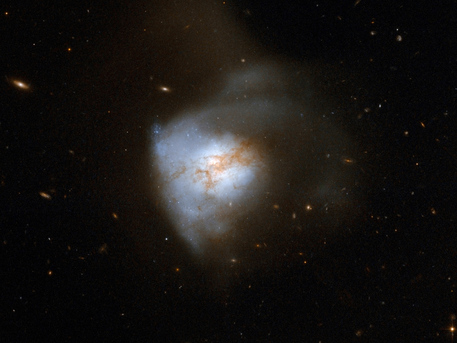Supercharged Star Factory
Sharpest View Ever of Star Factories
 |
Arp 220 is a nearby example of a merged starburst galaxy similar to SMM J2135-0102. Located 250 million light-years from Earth, Arp 220 is the aftermath of a collision between two spiral galaxies. The collision, which began about 700 million years ago, has sparked a crackling burst of star formation. The star clusters are the bluish-white bright knots visible in the Hubble image. (c) NASA, ESA, the Hubble Heritage-ESA/Hubble Collaboration, and A. Evans (UVa/NRAO/Stony Brook)
- » 1 - A Glimpse at the Past
- » 2 - Sharpest View
A Glimpse at the Past
"To a layperson, our images appear fuzzy, but to us, they show the exquisite detail of a Faberge egg," said Steven Longmore of the Harvard-Smithsonian Center for Astrophysics (CfA). Longmore is an author of the paper describing these findings, which was published in the March 21st Nature online.
Due to the time it takes light to travel to us, we see the galaxy as it existed just 3 billion years after the Big Bang. It was Milky Way-sized at the time. If we could see it today, 10 billion years later, it would have grown into a giant elliptical galaxy much more massive than our own.
"This galaxy is like a teenager going through a growth spurt," said Mark Swinbank of Durham University, lead author on the paper. "If you could see it today as an 'adult,' you'd find the galactic equivalent of Yao Ming the basketball player."
Supercharged Star Factory
Sharpest View Ever of Star Factories
 |
Arp 220 is a nearby example of a merged starburst galaxy similar to SMM J2135-0102. Located 250 million light-years from Earth, Arp 220 is the aftermath of a collision between two spiral galaxies. The collision, which began about 700 million years ago, has sparked a crackling burst of star formation. The star clusters are the bluish-white bright knots visible in the Hubble image. (c) NASA, ESA, the Hubble Heritage-ESA/Hubble Collaboration, and A. Evans (UVa/NRAO/Stony Brook)
- » 1 - A Glimpse at the Past
- » 2 - Sharpest View
A Glimpse at the Past
"To a layperson, our images appear fuzzy, but to us, they show the exquisite detail of a Faberge egg," said Steven Longmore of the Harvard-Smithsonian Center for Astrophysics (CfA). Longmore is an author of the paper describing these findings, which was published in the March 21st Nature online.
Due to the time it takes light to travel to us, we see the galaxy as it existed just 3 billion years after the Big Bang. It was Milky Way-sized at the time. If we could see it today, 10 billion years later, it would have grown into a giant elliptical galaxy much more massive than our own.
"This galaxy is like a teenager going through a growth spurt," said Mark Swinbank of Durham University, lead author on the paper. "If you could see it today as an 'adult,' you'd find the galactic equivalent of Yao Ming the basketball player."





